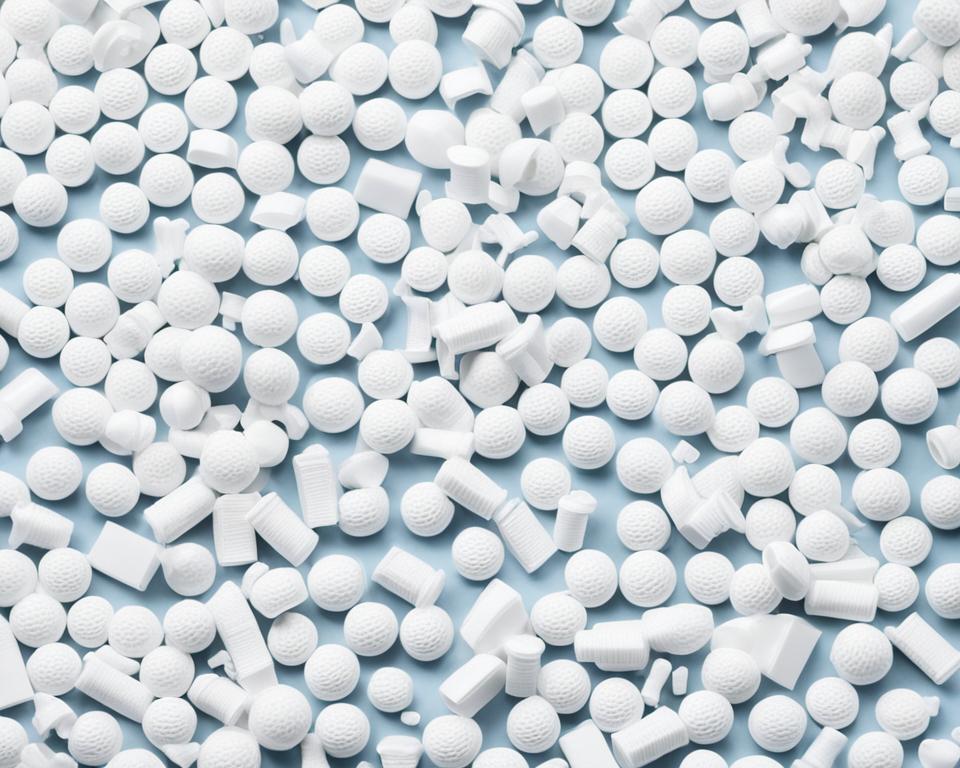Welcome to our article where we delve into the numerous applications of talc in everyday life. Talc, a naturally occurring mineral, plays a vital role in enhancing the quality and functionality of various industries and products.
Talc is widely utilized in cosmetics, pharmaceuticals, food manufacturing, paper production, plastics, paint and coatings, ceramics, and more. Its unique properties make it an invaluable ingredient that improves the performance and user experience of multiple products.
Join us as we discover how talc seamlessly integrates into our daily lives, from our skincare routines to the ceramics we use.
Key Takeaways:
- Talc finds versatile applications in numerous industries, such as cosmetics, pharmaceuticals, food manufacturing, paper production, plastics, paint and coatings, ceramics, and more.
- In cosmetics, talc provides a smooth and soft texture, making it an ideal ingredient for foundations, powders, and skincare products.
- Talc acts as a lubricant in pharmaceuticals, preventing ingredients from clumping together and ensuring precise dosage in medicines.
- Approved for use in food manufacturing, talc serves as an anti-caking agent, preventing ingredients from sticking and ensuring smooth processing.
- In the paper industry, talc enhances smoothness, opacity, ink absorption, and print quality, while reducing costs as a filler.
Talc in Cosmetics

Talc is a versatile ingredient commonly used in cosmetics, including makeup and skincare products. Its smooth and soft texture makes it an ideal addition to foundations, blushes, powders, and even baby powders.
One of the main benefits of talc in cosmetics is its ability to provide a silky feel on the skin. When applied, talc creates a smooth surface, giving makeup products a luxurious texture and making them easier to apply.
In addition to its texture-enhancing properties, talc also has absorbent qualities. It helps to control excess moisture and oil on the skin, making it particularly beneficial for individuals with oily or combination skin types. Talc absorbs sweat and oil, helping to keep the skin looking fresh and matte throughout the day.
Furthermore, talc is often used in talcum powder products. Talcum powder, a cosmetic staple for many, is primarily composed of talc and is used for various purposes, including reducing friction and absorbing moisture.
In summary, talc plays a significant role in the cosmetics industry by providing a silky texture, controlling excess moisture, and enhancing the overall performance of makeup and skincare products.
Examples of Talc in Cosmetics
| Product | Description |
|---|---|
| Foundation | Talc is often found in foundation formulas due to its ability to create a smooth, even finish on the skin. |
| Blush | Talc helps to provide a velvety texture and seamless application, giving cheeks a natural-looking flush. |
| Setting Powder | Talc absorbs excess oil, setting makeup and prolonging its wear time. |
| Baby Powder | Talcum powder, commonly used for babies, helps keep their delicate skin dry and comfortable. |
Talc in Pharmaceuticals

Talc plays a crucial role in the pharmaceutical industry, particularly in the production of medicines and tablets. Its unique properties make it an essential ingredient, contributing to the efficacy and overall quality of pharmaceutical products.
One of the key functions of talc in medicines is its lubricating properties. It prevents the ingredients in medicines from clumping together, ensuring that they are evenly distributed and allowing for accurate dosage. This is especially important in oral medications, where proper dosage is critical for effective treatment.
Talc is commonly used in the production of antacids, helping to improve their flowability and preventing them from sticking or caking. Its smooth texture aids in the digestion of antacids, enabling faster relief for individuals experiencing gastrointestinal discomfort.
In addition to antacids, talc is also used in various vitamins and other oral medications. By acting as a lubricant, talc allows for the smooth and easy swallowing of tablets, ensuring that patients can take their medications comfortably and conveniently.
“Talc’s lubricating properties make it a valuable ingredient in medicines, preventing clumping and ensuring accurate dosage.”
Moreover, talcum powder, which contains talc as its primary component, is used in certain pharmaceutical applications. Its absorbent nature makes it suitable for use in medicated powders and topical treatment formulations. Talcum powder helps to keep the skin dry, preventing irritation and discomfort in areas prone to sweating or friction.
Overall, talc’s lubricating properties and smooth texture make it a valuable ingredient in pharmaceutical products. From antacids to vitamins and medicated powders, talc’s versatility and effectiveness contribute to the success of various oral and topical medications.
Common Uses of Talc in Pharmaceuticals
| Application | Description |
|---|---|
| Tablet Lubrication | Talc prevents clumping and ensures proper dosage in oral medications. |
| Antacid Production | Talc improves flowability and prevents sticking in antacids. |
| Topical Treatments | Talcum powder aids in keeping the skin dry and preventing irritation. |
| Vitamin Manufacturing | Talc acts as a lubricant, facilitating the swallowing of vitamin tablets. |
Talc in Food Manufacturing
In the world of food production, talc serves an essential role as an anti-caking agent. Its ability to prevent ingredients from clumping together ensures the smooth processing and consistent quality of various food products.
Commonly found in powdered foods such as spices, baking mixes, and powdered sugar, talc acts as a natural barrier, keeping individual particles separate and free-flowing. This helps maintain the desired texture and appearance of the final food product.
“Talc’s anti-caking properties are invaluable in food manufacturing. They allow us to optimize production efficiency while guaranteeing that consumers receive the highest quality products.”
By preventing clumping, talc ensures that powdered ingredients mix evenly, reducing the chances of inconsistent flavor distribution. It also improves the dispersibility of food powders, making them easier to incorporate into recipes.
Furthermore, talc’s neutral taste and odor make it an ideal choice for food production, as it doesn’t affect the overall sensory experience of the final product.
To better understand the benefits of talc in food manufacturing, here’s a table outlining some of its applications:
| Food Product | Function of Talc |
|---|---|
| Spices | Prevents clumping of powdered spices, ensuring even distribution in recipes. |
| Baking Mixes | Improves the flowability and dispersibility of dry ingredients, allowing for consistent and accurate measurements. |
| Powdered Sugar | Prevents powdered sugar from forming lumps, ensuring a smooth texture when dusting desserts or making icings. |
| Seasoning Blends | Helps maintain the desired texture and consistency of seasoning mixes, preventing clumping and ensuring uniform flavor distribution. |
As you can see, talc plays a vital role in the food manufacturing industry, contributing to the overall quality and functionality of a wide range of products.
Next, let’s delve into another industry where talc finds extensive use: paper manufacturing.
Talc in Paper Manufacturing

Talc plays a significant role in the paper industry, contributing to the production of high-quality paper with improved characteristics. Its versatile properties make it an essential ingredient in paper manufacturing processes.
Firstly, talc enhances the paper’s smoothness, resulting in a pleasant writing or printing experience. Its fine particles create a uniform surface, reducing friction and allowing smoother ink flow. This quality makes talc an ideal choice for paper types such as writing paper, printing paper, and specialty papers.
Talc’s ability to absorb ink also makes it valuable in the paper industry. By increasing ink absorption, talc minimizes ink smudging and feathering, producing crisp and clear prints. This feature is especially important in applications where accurate reproduction of text, images, or graphics is essential.
Another significant advantage of using talc in paper manufacturing is its filler properties. Talc acts as a filler, reducing the overall cost of production while maintaining optimal paper quality. By adding talc to the paper mixture, producers can achieve the desired thickness and weight without using excessive amounts of expensive pulp fibers.
Let’s take a closer look at how talc’s characteristics in paper manufacturing compare to other fillers commonly used in the industry:
| Talc | Calcium Carbonate | Kaolin Clay |
|---|---|---|
| Improved smoothness | Good smoothness | Decent smoothness |
| Enhanced ink absorption | Moderate ink absorption | Standard ink absorption |
| Reduced ink smudging | Average ink smudging | Regular ink smudging |
| Cost-effective filler | Moderate cost-effectiveness | Standard cost-effectiveness |
As demonstrated by the table, talc offers superior qualities compared to other commonly used fillers. Its combination of smoothness, ink absorption, reduced ink smudging, and cost-effectiveness make it a preferred choice in the paper industry.
Talc: Making Paper Better
To summarize, talc plays a vital role in the paper manufacturing process by enhancing the paper’s smoothness, ink absorption, and print quality. Additionally, its filler properties contribute to cost savings without compromising paper performance. The inclusion of talc in paper production ensures a superior writing and printing experience, making it a valuable resource for the paper industry.
Talc in Plastics

Talc, a versatile mineral, is widely used in the plastics industry to enhance the performance and mechanical properties of plastic materials. By incorporating talc into plastic manufacturing processes, the resulting talc-filled plastics exhibit improved stiffness, impact resistance, and dimensional stability. This makes them ideal for applications that require strength and durability.
Talc-filled plastics find extensive use in various industries, including automotive, electrical, and household appliances. In the automotive sector, talc-reinforced plastics are utilized for manufacturing parts such as bumpers, dashboards, and interior trims. The addition of talc enhances the strength of these components, making them more resistant to impact and ensuring long-lasting performance.
Talc-filled plastics offer excellent mechanical properties and dimensional stability, making them suitable for a wide range of applications in the automotive industry.
In the electrical industry, talc-modified plastics are employed in electrical enclosures and housings. The inclusion of talc enhances the rigidity and impact resistance of these components, ensuring their ability to withstand the demanding conditions of electrical equipment.
Household appliances also benefit from the use of talc-filled plastics. By incorporating talc during the plastic manufacturing process, manufacturers can create durable and robust appliance components that can withstand daily use and provide long-term reliability.
To provide a clearer overview, the table below showcases the enhanced properties of talc-filled plastics compared to conventional plastics:
| Properties | Talc-Filled Plastics | Conventional Plastics |
|---|---|---|
| Stiffness | Increased | Lower |
| Impact Resistance | Improved | Lesser |
| Dimensional Stability | Enhanced | Lower |
As shown in the table, talc-filled plastics outperform conventional plastics by exhibiting increased stiffness, improved impact resistance, and enhanced dimensional stability. These properties make talc-filled plastics a preferred choice in industries where durability and performance are essential.
Notable Applications:
- Automotive parts, such as bumpers, dashboards, and trims
- Electrical enclosures and housings
- Household appliance components
By incorporating talc into plastic manufacturing, manufacturers can produce high-quality, robust plastic products that meet the demands of modern industries. Talc’s unique properties make it a valuable additive that significantly enhances the performance and functionality of plastics.
Talc in the Paint and Coating Industry

Talc, a versatile mineral, plays a crucial role in the paint and coating industry. It serves as a functional filler, improving the coverage, opacity, and durability of paints. Additionally, talc contributes to the smooth texture of paint, making it easier to apply.
Commonly used in both interior and exterior paints, primers, and industrial coatings, talc enhances the overall performance and finish of these products. Its unique properties make it an essential ingredient that enhances the quality and longevity of painted surfaces.
Here is an overview of the uses of talc in paint production and coatings:
- Improves coverage and opacity
- Enhances durability and resistance to wear
- Contributes to a smooth and even finish
- Aids in the prevention of cracking and peeling
- Provides better weather resistance
Talc in paint production is known for its ability to create a soft and velvety appearance on the painted surface. It also helps to control gloss levels, resulting in the desired sheen.
Furthermore, talc’s natural properties make it an environmentally friendly option for paint production. It is non-toxic and does not release harmful substances into the air, ensuring a safer working environment and better air quality in painted spaces.
Overall, talc’s versatility and unique properties make it an invaluable ingredient in the paint and coating industry, enabling the creation of high-quality, long-lasting finishes.
| Advantages of Talc in Paint Production and Coatings | Disadvantages of Talc in Paint Production and Coatings |
|---|---|
| Improves coverage and opacity | Possibility of increased drying time |
| Enhances durability and resistance to wear | Potential decrease in gloss levels |
| Contributes to a smooth and even finish | May require additional additives for desired performance |
| Aids in the prevention of cracking and peeling | Possibility of minor impact on color stability |
| Provides better weather resistance | – |
Talc in Ceramics

Talc plays a vital role in the ceramics industry, contributing to the production of high-quality and durable ceramic products. Its unique properties enhance the workability and firing characteristics of clay, making it a trusted ingredient in ceramic production and pottery.
One of the key benefits of talc in ceramics is its ability to improve the plasticity of clay. Plasticity refers to the ease with which clay can be shaped and molded. By adding talc to clay, ceramic artists and manufacturers can achieve greater control and precision in their creations.
Talc also helps to minimize cracking and shrinking during the drying and firing processes. When clay dries or undergoes firing, it tends to shrink, leading to potential flaws in the ceramic structure. However, the addition of talc helps reduce these negative effects, resulting in more resilient ceramics that are less prone to damage.
Moreover, talc aids in achieving the desired texture and smoothness of ceramic surfaces. It contributes to the overall aesthetic appeal of pottery and ceramic products, enhancing their visual appeal and tactile experience.
“Talc’s incorporation in ceramics enhances the plasticity of clay, reduces cracking and shrinking, and improves the overall quality of finished ceramic products.”
| Talc in Ceramics | Benefits |
|---|---|
| Enhances plasticity | Allows easier shaping and molding of clay |
| Reduces cracking and shrinking | Results in more durable ceramics |
| Improves surface texture | Enhances the visual appeal of pottery |
Conclusion
In conclusion, talc is a versatile mineral that plays a significant role in various aspects of our daily lives. From cosmetics to pharmaceuticals, food manufacturing to ceramics, talc’s unique properties make it a valuable ingredient that enhances the quality and performance of numerous products.
When it comes to cosmetics, talc’s smooth and soft texture is sought after for its ability to provide a silky feel to foundations, blushes, powders, and even baby powders. In skincare products, talc helps absorb excess moisture, leaving a comfortable and dry sensation.
In the pharmaceutical industry, talc acts as a lubricant, ensuring precise dosage and preventing ingredients from clumping together. Commonly found in antacids, vitamins, and other oral medications, talc ensures the effectiveness and usability of these essential products.
Additionally, talc is widely used in food manufacturing to prevent ingredients from sticking together, allowing for smoother processing and consistent quality. It can be found in powdered foods such as spices, baking mixes, and powdered sugar.
Furthermore, talc’s application in industries like paper manufacturing, plastics, paint, and coatings, as well as ceramics, showcases its versatility and adaptability. In each sector, talc enhances the performance and characteristics of the final product, such as improving ink absorption in paper, mechanical properties in plastics, and smooth texture in paint and coatings.
Without a doubt, talc continues to contribute to our daily experiences, whether we’re applying makeup, taking medicine, enjoying our favorite foods, or utilizing various manufactured products. Its presence enhances and elevates our overall satisfaction and satisfaction with the functionalities they offer.
FAQ
What are the diverse uses of talc?
Talc has a wide range of uses in various industries and products. It is commonly found in cosmetics, pharmaceuticals, food manufacturing, paper production, plastics, paint and coating industry, and ceramics.
How is talc used in cosmetics?
Talc is commonly used in makeup and skincare products. Its smooth and soft texture makes it an ideal ingredient for foundations, blushes, powders, and baby powders. It provides a silky feel and absorbs excess moisture.
What is the role of talc in pharmaceuticals?
Talc is used in the production of medicines and tablets as a lubricant. It prevents ingredients from clumping together, ensuring proper dosage. It is commonly found in antacids, vitamins, and oral medications.
How is talc utilized in food manufacturing?
Talc is approved for use in food manufacturing and acts as an anti-caking agent. It prevents ingredients from sticking together, ensuring smooth processing. It is commonly found in powdered foods like spices, baking mixes, and powdered sugar.
What is the role of talc in paper manufacturing?
Talc is used in the paper industry to improve the paper’s smoothness and opacity. It enhances ink absorption, reduces ink smudging, and acts as a filler, making paper production more cost-effective.
How does talc contribute to plastic manufacturing?
Talc is added to plastics to enhance their mechanical properties. It increases stiffness, impact resistance, and dimensional stability. Talc-filled plastics are used in automotive parts, electrical enclosures, and household appliances.
What are the uses of talc in the paint and coating industry?
Talc is a crucial ingredient in various paints and coatings. It acts as a functional filler, improving coverage, opacity, and durability. It contributes to the smooth texture of paint and is commonly used in interior and exterior paints, primers, and industrial coatings.
How is talc utilized in ceramics?
Talc is extensively used in the ceramics industry to improve the workability and firing characteristics of clay. It enhances plasticity, reduces cracking and shrinking during drying and firing, resulting in more durable ceramics.
What are the uses of talc in our daily lives?
Talc finds diverse applications in our daily lives, from cosmetics and pharmaceuticals to food manufacturing and ceramics. Its unique properties enhance the quality and performance of various products, improving our experiences in using them.




